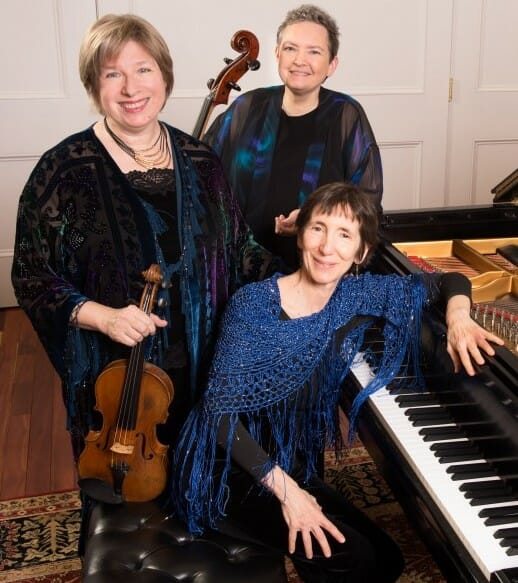Dances and Meditations
Blended – Terry Carter
Excerpts from “Armenian Miniatures” – V. Komitas (1869-1935), arr. Aslamazyan
1. Dear Shogher
2. She is Slender Like a Plane Tree
3. Oh Nazan
4. Festive Song
Excerpts from “Teen Murti” – Reena Esmail (b. 1983)
Mother and Child – William Grant Still (1895-1978)
Helena Froehlich
Kitchen Table – Terry Carter & Jonathan Fagan
Intermission
Blended – Terry Carter & Jonathan Fagan
Suite Argentina No. 1: Hueya – Alberto Williams (1862-1952)
Flower Communion – Music: Adoration – Florence Price (1887-1953)
Helena Froehlich & CreationDance
Legacy (poetry by Terry Carter, music by Jonathan Fagan)
Hard By the Mystic (poetry by Terry Carter, music by Jonathan Fagan)
Beloved Country (poetry by Terry Carter, music by Jonathan Fagan)
Neighborhood – Terry Carter & Jonathan Fagan
Performers:
The Ally Project
Terry Carter, poetry & narration
Jonathan Fagan, piano & composition
Gordon Engelgau, drums
Max Ridley, bass
CreationDance
Helena Froehlich
Lynn Menegon
Ashley Reynolds
Edward Keazirian
Annie Farrell
Orchestra Without Borders
Luca Antonucci, conductor
violin 1: Peter Paetkau*, Matthew Lamb, Katianna Nardone, Jen Hsiao
violin 2: Jackie Bensen, Eya Setsu, Hope Yuan
viola: Stephen Moss, Rebecca Strauss
cello: Taylor Stobinski
bass: Chris Hernandez, Max Ridley







 told us that none of the teachers had contracted the virus, but he said, “Cases in our area are increasing every day.”
told us that none of the teachers had contracted the virus, but he said, “Cases in our area are increasing every day.” CWB is funding one of Sekelela’s teachers, Eunice Nachimata, for a three-year program to get her teacher’s license. The pandemic paused her schooling, but the program was recently reopened online. We have provided Ms. Nachimata with a new smart phone and internet access so she is able to continue her education online. She is the third teacher we have sponsored.
CWB is funding one of Sekelela’s teachers, Eunice Nachimata, for a three-year program to get her teacher’s license. The pandemic paused her schooling, but the program was recently reopened online. We have provided Ms. Nachimata with a new smart phone and internet access so she is able to continue her education online. She is the third teacher we have sponsored.








 When the award-winning and internationally known
When the award-winning and internationally known  Michelle LaCourse has appeared as soloist and chamber musician on four continents, and has released two highly acclaimed CDs of works (all world premiere recordings) for viola and piano. She was formerly a member of the Lehigh Quartet, the Delphic String Trio, and the Aeolian Trio, and has performed at numerous festivals such as Aspen, Bowdoin, Skaneateles, Musicorda, the Heifetz Institute, Campos do Jordão (Brazil), and Positano (Italy) and in major musical centers around the world. She currently teaches viola and chairs the String Department at Boston University’s School of Music.
Michelle LaCourse has appeared as soloist and chamber musician on four continents, and has released two highly acclaimed CDs of works (all world premiere recordings) for viola and piano. She was formerly a member of the Lehigh Quartet, the Delphic String Trio, and the Aeolian Trio, and has performed at numerous festivals such as Aspen, Bowdoin, Skaneateles, Musicorda, the Heifetz Institute, Campos do Jordão (Brazil), and Positano (Italy) and in major musical centers around the world. She currently teaches viola and chairs the String Department at Boston University’s School of Music. 

 Soprano Deborah Selig’s voice has been described as “radiant,” “beautifully rich,” “capable of any emotional nuance,” and “impressively nimble.” She performs repertoire spanning music from the baroque to contemporary in opera, oratorio and art song. She has degrees from University of Michigan and Cincinnati College-Conservatory of Music, and she serves on the voice faculties of Wellesley College, Brown University, and the summer Boston University Tanglewood Institute.
Soprano Deborah Selig’s voice has been described as “radiant,” “beautifully rich,” “capable of any emotional nuance,” and “impressively nimble.” She performs repertoire spanning music from the baroque to contemporary in opera, oratorio and art song. She has degrees from University of Michigan and Cincinnati College-Conservatory of Music, and she serves on the voice faculties of Wellesley College, Brown University, and the summer Boston University Tanglewood Institute.  Boston-based mezzo-soprano Britt Brown has performed with Boston Midsummer Opera, Boston Opera Collaborative, MetroWest Opera, the Boston Lyric Opera, Odyssey Opera, Guerilla Opera and the Boston Pops. She premiered several pieces with Juventas New Music Ensemble. Britt is a graduate of Stetson University and the Boston Conservatory and continues to teach and perform locally as a sought-after new and sacred music singer.
Boston-based mezzo-soprano Britt Brown has performed with Boston Midsummer Opera, Boston Opera Collaborative, MetroWest Opera, the Boston Lyric Opera, Odyssey Opera, Guerilla Opera and the Boston Pops. She premiered several pieces with Juventas New Music Ensemble. Britt is a graduate of Stetson University and the Boston Conservatory and continues to teach and perform locally as a sought-after new and sacred music singer.  Praised for his fine musicality, “glowing intensity,” and “clarion tone,” Gregory Zavracky maintains an active performance schedule on concert and opera stages, including Boston Lyric Opera, American Repertory Theater, Chautauqua Opera, Opera Saratoga, Opera in the Heights, Rhode Island Philharmonic, Utah Symphony. His compositions include several song cycles, three operas, and a number of choral and chamber works. He has a DMA in voice performance from Boston University, and teaches at the University of Connecticut, Boston University Tanglewood Institute, and Brown University.
Praised for his fine musicality, “glowing intensity,” and “clarion tone,” Gregory Zavracky maintains an active performance schedule on concert and opera stages, including Boston Lyric Opera, American Repertory Theater, Chautauqua Opera, Opera Saratoga, Opera in the Heights, Rhode Island Philharmonic, Utah Symphony. His compositions include several song cycles, three operas, and a number of choral and chamber works. He has a DMA in voice performance from Boston University, and teaches at the University of Connecticut, Boston University Tanglewood Institute, and Brown University.  Baritone Ryne Cherry is an opera, oratorio, and ensemble singer based in Boston. He has premiered numerous new works. In the summer of 2017, Ryne enjoyed his second season as a vocal fellow at Tanglewood, the Boston Symphony Orchestra’s summer home. “Baritone Ryne Cherry has a voice of real beauty and his velvety tone was well-suited for Pietro’s legato passages.” (Examiner.com)
Baritone Ryne Cherry is an opera, oratorio, and ensemble singer based in Boston. He has premiered numerous new works. In the summer of 2017, Ryne enjoyed his second season as a vocal fellow at Tanglewood, the Boston Symphony Orchestra’s summer home. “Baritone Ryne Cherry has a voice of real beauty and his velvety tone was well-suited for Pietro’s legato passages.” (Examiner.com)  Anne Watson Born is the Music Director of the Nashoba Valley Chorale. She is also the Director of Music Ministry at the First Unitarian Universalist Society in Newton. She is the Board chair of the Music Leadership Certification Committee for the Unitarian Universalist Association. She has been a faculty member at Roxbury Community College and at Bristol Community College. Ms. Watson Born holds a M.M. degree from New England Conservatory.
Anne Watson Born is the Music Director of the Nashoba Valley Chorale. She is also the Director of Music Ministry at the First Unitarian Universalist Society in Newton. She is the Board chair of the Music Leadership Certification Committee for the Unitarian Universalist Association. She has been a faculty member at Roxbury Community College and at Bristol Community College. Ms. Watson Born holds a M.M. degree from New England Conservatory. 

